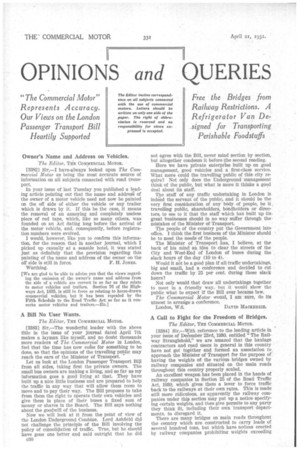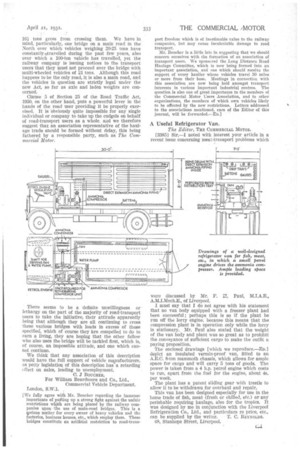OPINIONS and QUERIES
Page 52

Page 53

If you've noticed an error in this article please click here to report it so we can fix it.
"'The Commercial Motor" Represents Accuracy. Our Views on the London Passenger Transport Bill Heartily Supported Free the Bridges from Railway Restrictions. A Refrigerator Van Designed for Transporting Perishable Foodstuffs
Owner's Name and Address on Vehicles.
'The Editor, THE COMMERCIAL MOTOR.
[3382] Sir,—I have, always looked upon The Commercial Motor as being the most accurate source of information on all subjects connected with road transport, In your issue of last Tuesday you published a leading article pointing out that the name and address of the owner of a motor vehicle need not now be painted on the off side of either the vehicle or any trailer which is drawn by it. If this be the case, it means the removal of an annoying and completely useless piece of red tape, which, like so many others, was founded on an Act dating long before the arrival of the motor vehicle, and, consequently, before registration numbers were evolved.
I would, however, like you to confirm this information, for the reason that in another journal, which I picked up casually at a seaside hotel, it was stated just as definitely that the provision regarding this painting of the name and address of the owner on the
off side is still in force. F. H. JONES. Worthing.
[We are glad to be able to advise you that the views regarding the omission of the owner's name and address from the side of a vehicle are correct in so far as they relate to motor vehicles and trailers. Section 76 of the Highways Act, 1835, is still in force as relating to horse-drawn commercial vehicles, but it has been repealed by the Fifth Schedule to the Road Traffic Act so far as it concerhs motor vehicles and trailers.—Eo.]
A Bill No User Wants.
The Editor, THE COMMERCIAL MOTOR.
[3383] Sir,—The wonderful leader with the above title in the issue of your journal dated April 7th makes a layman like myself, and DO doubt thousands more readers of The_ Commercial Motor in London, feel that the time has now cothe for something to be done, so that the opinions of the travelling public may reach the ears of the Minister of Transport.
Let us look at the London Passenger Transport Bill from all sides, taking first the private owners. The small bus owners are making a living, and so far as my information goes a good living at that. They have built up a nice little business and are Prepared to help the traffic in any way that will allow them room to move and to pay their way. The Bill proposes to take from them the right to operate their own vehicles and give them in place of their buses a fixed sum of money or shares in the Board. The Bill says nothing about the goodwill of the business.
Now we will look at it from the point of view of the London Underground Combine. Lord Ashfield did not challenge the principle of the Bill involving the policy of consolidation of traffic. True, but he should have gone one better and said outright that he did e30 not agree with the Bill, never mind section by section, but altogether condemn it before the second reading.
Here we have private enterprise built up on good management, good vehicles and a first-class service. What more could the travelling public of this city require? Not only does the Underground management think of the public, but what is more it thinks a good deal about its staff.
The staff of any traffic undertaking in London is indeed the servant of the public, and it should be the very first consideration of any body of people, be it, travelling public, shareholders, bondholders or directors, to see to it that the staff which has built up its great !businesses should in no way suffer through the mistakes of the Minister of Transport.
The people of the country put the Government into office. I think the first business of the Minister should be to meet the needs of the people.
The Minister of Transport has, I believe, at the back of his mind an idea to clear the streets of the City and West-End of London of buses during the slack hours of the day (10 to 4).
Would it not be a good plan if all traffic undertakings, big and small, had a conference and decided to cut down the traffic by 25 per cent, during these slack hours?
Not only would that draw all undertakings together to meet in a friendly way, but it would show the public what to expect if the Bill ever became law. The Commercial Motor would, I am sure, do its utmost to arrange a conference.
London, W.6. DAVID MACKENZIE.
A Call to Fight for the Freedom of Bridges.
The Editor, THE COMMERCIAL MOTOR.
[3384] Sir,—With reference to the leading article in your issue of December 23rd, 1930. entitled "The Railway Stranglehold," we are amazed that the haulage contractors and road users in general in this country have not got together and formed an association to approach the Minister of Transport for the purpose of having the weights of the various bridges owned by railway companies and situated on the main roads throughout this country properly scaled. An excellent weapon has been placed in the hands of railway companies in Section 25 of the Road Traffic Act, 1930, which gives them a lever to force traffic back to the railways at their own rates. This is made still more ridiculous, as apparently the railway companies under thip section may put up a notice specifying certain weights, and then give permits to any party they think fit, including their own transport departments, to disregard it. There are many bridges on main roads throughout the country which are constructed to carry loads of several hundred tons, but which have notices erected by railway companies prohibitinz weights exceeding
161, tons gross from crossing them. We have in mind, particularly, one bridge on a main road in the North over which vehicles weighing 20-25 tons have constantly 'travelled during the past few years, also over which a 100-ton vehicle has travelled, yet the railway company is issuing notices to the transport users that they must not proceed over the bridge with multi-wheeled vehicles of 21 tons. Although this road happens to be the only road, it is also a main road, and the vehicles in question are strictly legal under the new Act, so far as axle and laden weights are concerned.
Clause 5 of Section 25 of the Road Traffic Act, 1930, on the other hand, puts a powerful lever in the hands of the road user providing it be properly exercised. It is 'obviously quite impossible for any single individual or company to take up the cudgels on behalf of road-transport users as a whole, and we therefore suggest that an association representative of the haulage trade should be formed without delay, this being fathered by a responsible party, such as The Commercial Motor.
There seems to be a definite unwillingness or lethargy on the part of the majority of road-transport users to take the initiative, their attitude apparently being that although they are all continuing to cross these various bridges with loads in excess of those specified, which of course they lire compelled to do to earn a living, they are hoping that the other fellow who also uses the bridge will be tackled first, which is, of course, an impossible attitude, and one which cannot continue.
We think that any association of this description would have the full support of vehicle mamfacturers, as petty legislation of this description has a retarding effect on sales, leading to unemployment.
C. J BOUCHER,
For William Beardmore and Co., Ltd., Commercial Vehicle Department. London, S.W.1.
[We fully agree with Mr. Boucher regarding the immense importance of putting up a strong fight against the unfair restrictions which are being placed by the railway companies upon -the use of main-road bridges. This is a vrious matter for every owner of heavy vehicles and the factories, business houses, etc., which employ them. These bridges constitute an artificial restriction to road-trans
port freedom which is of inestimable value to the railway companies, but may cause incalculable damage to road transport.
Mr. Boucher is a little late in suggesting that we should concern ourselves with the formation of an association of transport users. We sponsored the Long Distance Road Haulage Committee, which is now being formed into an important association, and one which should receive the support of every haulier whose vehicles travel 30 miles or more from their base. Meetings in connection with this association are now being held amongst transport interests in various important industrial centres: The question is also one of great importance to the members of the Commercial Motor Users Association, and to other organizations, the members of which own vehicles likely to be affected by the new restrictions. Letters addressed to the associations mentioned, care of the Editor of this journal, will be forwarded.—En.) A 'Useful Refrigerator Van.
The Editor, THE COMMERCIAL MOTOR.
[3385] Sir,—I noted with interest your article in a recent issue concerning meat-transport problems which
were discussed by Mr. F. U. Paul, M.I.A.E., A.M.I.Mech.E., of Liverpool.
I must say that I do not agree with his statement that no van body equipped with a freezer plant had been successful; perhaps this is so if the plant be run off the lorry engine. because this means that the compression plant is in operation only while the lorry is stationary. Mr. Paul also stated that the weight of the van body and plant was so great as to prohibit the conveyance of sufficient cargo to make the outfit a paying proposition.
The enclosed drawings [which we reproduce.—EP.] depict an insulated vermin-proof van, fitted to an A.E.C. 8-ton mammoth chassis, which allows for ample space for cargo and will carry 5 tons of goods. The power is taken from a 4 h.p. petrol engine which costs to run, apart from the fuel for the engine, about 4s. per week.
The plant has a patent sliding gear with trestle to allow it to be withdrawn for overhaul and repair.
This van has been designed especially for use in the home trade of fish, meat (fresh or chilled, etc.) or any perishable requiring haulage, also for the tropics. It was designed by sue in conjunction with the Liverpool Refrigeration Co., Ltd., and particulars re price, etc.,
can be supplied by the writer. T. C. REYNOLDS. 68, Stanhope Street, Liverpool.












































































































